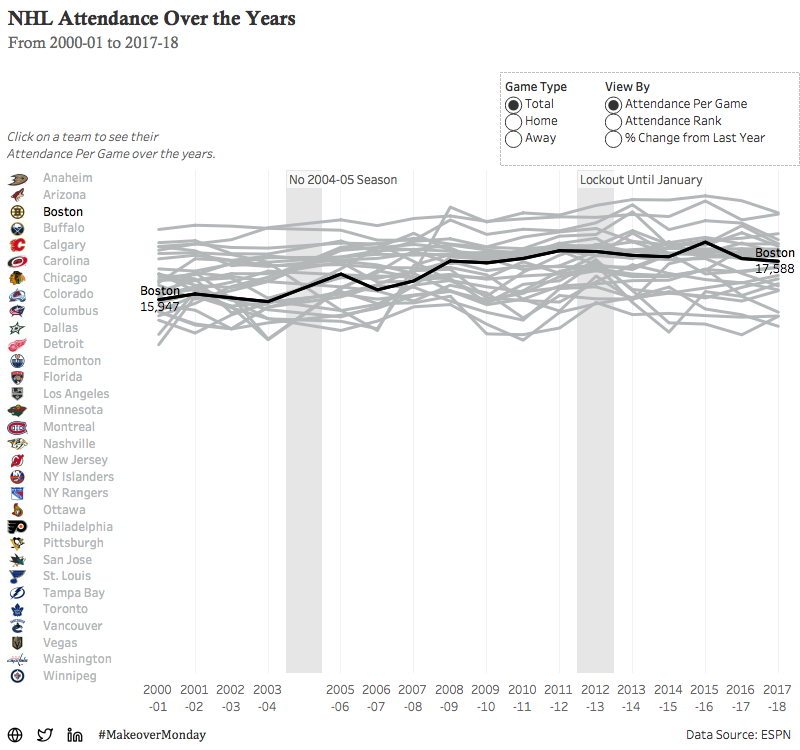MoM | 2019W02
What Works Well?
Quick glance at the map allows you to find your country and determine your press freedom’s classification (free, partly free, not free). Unfortunately, that is about it as far as this single visualization goes. However, the site as a whole serves as a dashboard with drill down ability. You’re able to get more info about a particular country/year using the filters provided as well as the breakdown of the score & methodology.
What Can Be Improved?
Immediately you have to wonder: is this better or worse than last year? The first year? Our worst year? Having some trend of data would be greatly appreciated. The other unfortunate result of using a globe is the land area of the different countries (Russia, China, Canada, etc.) causes their colors to fill more of the view. This can easily alter your perception of the data. Lastly, one might want to see the overall breakdown by # countries, # population, etc. by press freedom category.
My approach
I wanted to use this week to try a few things I don’t normally get to or have never done. I’ll walk through each and how I used them.
Dynamic Top/Bottom N
I’ve spent a fair amount of time on Set Actions lately, but I wanted to use sets in their traditional methodology: returning Top N based on a field. When profiling the data I realized that not all countries spanned the 1994 – 2017 edition range. Due to that, I wanted to calculate the first year a country was included in Freedom House scoring to compare to this past year’s scoring.
I then developed two sets: SetCountry_TopRank and SetCountry_BottomRank. For SetCountry_TopRank I subtracted the country’s first edition rank from the country’s score last year ([CF_CountryScore_Last]-[CF_CountryScore_First]). Contrasly, SetCountry_BottomRank was the reverse. You’ll notice I used a parameter (PA_Rank) to allow the user to determine how many countries to focus on.
Lastly: coloring. Using these two sets I simply created a calculation that checked for either of these sets and assigned values/colors accordingly (blue for Bottom Rank – increase in press freedom, orange for Top Rank – increase in restriction). More on this in a moment!
Concatenated List
Admittedly I have used this before, but I felt it was a good case to use this again and provide the user a quick call out. After filtering the set, we can use a table calculation to concatenate the list of countries and their change in score within the Top N.
First: concatenate the country and it’s score change into a string.
Second: build the concatenated list. If it’s the first row we simply assign it it’s own string, otherwise we need to add each row’s string onto the previous one with a comma.
Third: hide all rows that are not the last row. Thankfully this is pretty simple by creating a LAST=0 calculating and right click – hide on FALSE. Beautiful!
I thought I was done here, but then I felt the increase in press censorship deserved a darker color palette than the white background I was using… This made me want to investigate the option of transparent worksheet backgrounds similar to this dashboard by Ken Flerlage.
Transparent Worksheet Backgrounds
This was another fantastic addition to Tableau that many of us have been waiting for. While not allowing a dynamic background color, we can use transparent worksheet backgrounds and a floating container to obtain the desired behavior. Unfortunately, this also required modifying each sheet to ensure the text would be visible. Easy, but a bit more work.
My idea was to allow the user to focus on one particular view: less restriction or more censorship. Toggling this would affect the color palette and the Top N countries they would be looking at. Here’s one of the calculations (used for the Title).
By applying this sort of calculation to most sheets and modifying previous color calculations to confirm they were using this certain view we could create a more exciting visualization, in my opinion.
In Closing
There are definitely things I would consider exploring more:
% of countries in each category (free, partly free, not free)
trend % of countries in each category
blend with population data
blend with education data
blend with type of government
And much more. There are some things I would do differently, but I truly enjoyed practicing techniques I don’t normally do.











